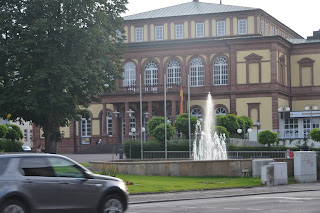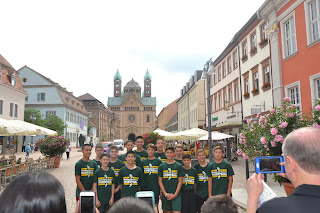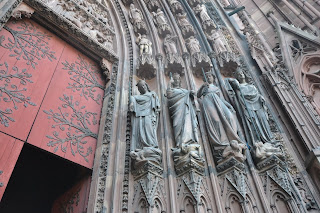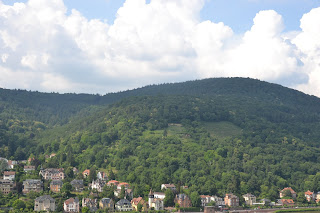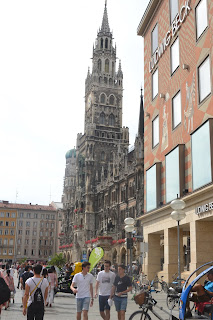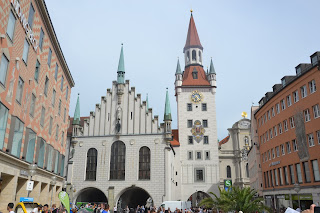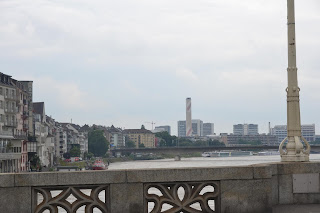Here we go again! The anticipation has been sky high. For weeks...no months, we have been talking about this trip, preparing, making lists, and making sure we have everything lined up to travel across the world...literally. Finally, today is the day we have been waiting for!
Last year, Carson and I traveled with his SFS team to China - for a once in a lifetime opportunity to see a different part of the world and play some basketball at the same time. Although it was a trip neither he or I will ever forget, we missed the rest of our family dearly. This year, when the team decided to travel to Germany, Jason and I decided to make it a family trip.
Preparing for a family of 5 to travel from San Antonio, TX to Germany was a feat. Passports, clothes, uniform, snacks, toiletries, and electronics were among the long lists of things to pack. All 3 kids were ecstatic to get to travel abroad!
Carson works his tail off every day to be a part of the SFS 14U Black Team. He trains tirelessly with DJ (David Jones). Carson is not the fastest, not the strongest, and can't jump the highest, but he has the biggest heart that I have ever seen on a 13 year old boy. The dedication he has to basketball is one that you only read about. The boy won't let "no" be an answer. We are so proud of his work ethic and thrilled that he is a part of this amazing SFS family. There are a lot of kids that would give their right arm to be on this team. Carson has earned his jersey and will no doubt give it everything he has when he steps on the court in Germany.
Kennedi and Cade are so excited! They have talked about this trip for almost a year now. They have participated in the fundraising events and have played an active part in the trip preparation. They told their friends at school and Cade even took a book about Germany to school for show and tell! I am so happy that all 5 of us are going together. It will no doubt be one of the best experiences we will ever have as a family!
Go time! Our flight left San Antonio at 4:22 p.m. The first leg was a quick flight to Houston. There was no time when we got to Houston to dilly dally. We immediately boarded out next flight which was from Houston to Frankfort, 10 hours. We had 3 seats in the Economy Plus section for a little extra leg room, which was well worth it. The littles sat 2 rows behind us. We watched movies and tried to sleep. The food was...just ok.
June 6, 2018
We landed in Frankfurt about 11:15 a.m. on June 6th. The time difference is 7 hours, so it is 4:15 a.m. at home. We are tired, but feeling pretty good. Our group was on 2 different flights, so we had an hour to kill while we waited on the 2nd flight to arrive. We exchanged some money for Euros and got a bite to eat. When the other group arrived, we loaded a tour bus- all 54 of us - and drove about an hour to our hotel in Neustadt.. We are staying at Achat. It is such a cute little town! We got our bags and settled into our rooms. Jason, Carson and Cade are on the 4th floor. Kennedi and I are on the 2nd floor. There is no AC, but with the windows open, there is a little breeze. The temperature outside is mid 80's. We rested for just a bit before our welcome dinner.
At 6:00 we gathered in the small courtyard at our hotel for our first German beer. It was really good! The weather was perfect! Shorts and tanks were the attire, but it wasn't balmy or too hot. We had a quick team meeting with our tour guide, Kristy, to go over the rules and itinerary before dinner. The dinner was buffet style - soup, chicken, fish, potato pockets (my favorite!), potato pasta and rice. Delicious!!
After dinner we took a stroll down the streets of Neustadt. It is such a quaint, beautiful old city! We had some photo opportunities, the kids played in the water fountain, we ate ice cream, and took in the awe of being 5000 miles from home in a land full of beauty and culture.
June 7, 2018
It's game day! Today was super busy! We are all so exhausted. But, the sites were amazing, as was the basketball!
This morning we had a buffet breakfast in the hotel. Donuts, eggs, sausage, bacon, and coffee. At 9:45 a.m. we boarded the tour bus and drove 30 minutes to Speyer. Speyer is a beautiful, small town full of history and culture. We walked the cobblestone streets and marveled at the small houses, beautiful architecture, plush landscaping and quaint city side.
Our first stop was to meet the mayor of Speyer. She hosted our group in the city building and gave us some history and facts about Speyer. We got to enjoy pretzels and apple cider before heading back out on the tour.
The history of Speyer begins with the establishment of a Roman camp in 10 BCE, making it one of Germany's oldest cities. Its name evolved from Spira, first mentioned in 614. As of 1294 a Free Imperial City, the town became renowned for its Romanesque cathedral, its vibrant Jewish community, its seat of the Imperial Chamber Court, for 50 diets that took place within its walls, most notably 1526 and 1529, and last but not least, for the Protestation at Speyer. For several centuries from the Middle Ages into the early modern period, Speyer was one of the main centres of gravity of the Holy Roman Empire.
Lunch was in a cute little German restaurant. The food was great and Jason and I got to enjoy another German beer. The brew master in this restaurant was the mayor's son. Then, we got to visit the biggest Romanesque church in the world. It was absolutely beautiful!
Speyer Cathedral in the Rhineland-Palatinate region has long since ceased to be the largest church in the western world. However, it is still the world's largest surviving Romanesque church. Construction began under Salian Emperor Konrad II, and the church was consecrated in 1061 under his grandson Heinrich IV. Its huge triple-naved vaulted basilica is the central element of a design that is thought to have greatly influenced Romanesque architecture in the 11th and 12th century. The mighty but eminently well-proportioned main building, consisting of the nave and transept with four towers in a symmetrical design, inspired many other important churches. A central attraction that strongly reflects the spirit of the time is the fully preserved crypt, which is the largest Romanesque columned hall in Europe. As the burial site for Salian, Hohenstaufen and Habsburg rulers and their wives, the crypt – and the cathedral itself – represent the ultimate symbol of medieval imperial power. The huge 'cathedral bowl' outside the main door is certainly worth a visit. With a capacity of 1,560 litres, it had to be filled with wine by every new bishop to keep the people happy. Perhaps these are the origins of the Cathedral Wine Fair in spring at which Palatinate vineyards present their wines against the stunning backdrop of the cathedral. Every year in September and October, the International Music Festival is held at Speyer Cathedral. It features concerts by choirs and orchestras, as well as organ recitals.
Finally, we headed the gym for our first game in Germany. We played against another 14U Club team. The boys were pretty tired and were trying to fight off jet lag, but they played great! We won 95-73. Carson scored 4 points, had a steal and an assist! We are so proud of him and all the boys on this great team.
We drove back to our hotel in Neustadt. By then it was almost 9:00 p.m. We found a small pizzeria to satisfy our hunger and topped it off with gelato. Tomorrow we have to be up early, so we headed to bed, exhausted, but so happy to have this opportunity of a lifetime.
June 8, 2018
Today we traveled to Strasbourg France. It was about an hour drive from our hotel. Strasbourg was beautiful! Cobblestone roads, flowers in every window, amazing architecture and in the city center was the Notre Dame Cathedral - absolutely stunning! Gorgeous windows, soaring ceilings, detailed carvings, and ornate decor. I can only imagine what it would be like to worship in such a magical building. In Strasbourg we had some free time so we did a little shopping and then enjoyed a crepe and coffee while we people watched in the city square. It was truly like being in a scene from the movies!
Strasbourg’s Notre-Dame Cathedral is one of Europe's most beautiful example of gothic architecture. The stunning pink sandstone façade is quite unique and breath taking. Be sure to go inside for the intricate carvings and stained glass windows. Each day at 12:30 pm, visitors can see the 1842 astrological clock put on its special and lengthy show.
Once we returned from Strasbourg the bus took us into Heidelberg. Heidelberg was equally beautiful. The Neckar River wound through town. Big, beautiful homes adorned the banks of the river. We walked the quaint streets and admired rich culture and old-style German structures. Then, we walked up 266 steps to see the Heidelberg castle. The castle was built for royalty. This was the first castle I had ever seen in person and it was all I thought it would be. A mote (dry) surrounded the walls, an iron gate was built to drop and protect the castle, and the tower provided magical views over the city and the river. We definitely enjoyed some amazing photo opportunities.
Nestled in the hill 300 feet above the city of Heidelberg stands the breath-taking Heidelberg Schloss (castle). The castle is a combination of several buildings surrounding an inner courtyard, put together with a haphazard look. Each building highlights a different period of German architecture.
The castle has a history almost as old as the city itself. The first parts of the castle were constructed around 1300, but it wasn’t before Prince Elector Ruprecht III (1398 – 1410) that the castle was used as a regal residence. Until it was destroyed by lightning in 1764 leaving it permanently uninhabitable, the castle was the residence for most of the Prince Electors. In 1800, Count Charles de Graimberg began the difficult task of conserving the castle ruins. Up until this time, the citizens of Heidelberg had used the castle stones to build new houses.
Just as breath-taking as the castle is from the city, so too is the city from the castle. From either the Great Terrace or the gardens, one has an amazing view of Heidelberg, the Neckar River, and the Neckar valley far into the Rhine plain. On a clear day, Mannheim is even visible on the horizon.
We stopped at a cute little bakery for sandwiches and a beer in Heidelberg before we headed back to the hotel - Leonardo Hotel in Heidelberg. In this hotel we have 2 adjoining rooms which were much bigger and AC! It was a long day and the kids needed some down time so we headed to the pool for a little R&R. The kids swam and the adults "socialized" poolside. What a day to remember!!
June 9, 2018
Frankfurt Germany was on the agenda today. An hour bus ride into the city, then a guided tour filled the morning hours. We got to see the city hall and learn all about the history of Frankfort, including stories about emperors and the destruction the city experienced. The cathedral in the city center was definitely the highlight. I can't really even describe the beauty of the building and the depth of history for the city of Frankfurt. Also in the city square we got to eat Frankfurters - sausage in a pretzel bun - so yummy and a perfect, German style snack!
Frankfurt am Main was a free imperial city from 1372 until 1806, when Napoleon I made it the seat of government for the prince primate of the Confederation of the Rhine. In 1810 the city became the capital of the Grand Duchy of Frankfurt, created by Napoleon. From 1815, when Napoleon fell, Frankfurt was again a free city, where in 1848–49 the Frankfurt National Assembly met. From 1816 to 1866 the city was the seat of the German Bundestag (Federal Diet) and thus the capital of Germany. After the Seven Weeks’ War in 1866, Frankfurt was annexed by Prussia and thereby lost its free-city status. It was only after its integration into a united Germany that Frankfurt developed into a large industrial city.
International trade fairs have been held in Frankfurt since 1240, and the city is now a leading commercial, financial, and high-technology centre. There is an important stock exchange (first established in 1585). The Rothschild family started building its international banking empire in Frankfurt. The city also is the home of the European Union’s central bank. Annual book, automobile, and computer fairs are popular events, and there are many other fairs held throughout the year. Manufactures include automobiles, machinery, chemical and pharmaceutical products, printing materials, and foodstuffs. The city is traditionally known for its production of high-quality sausages (frankfurters).
Frankfurt has long been a key stopping point for river, rail, and road traffic from Switzerland and southern Germany northward along the Rhine River to the Ruhr region and across the Main River to north-central Germany. It is still the chief traffic hub for western Germany and has also been an important inland shipping port since the canalization of the Main in the 1880s. Frankfurt Airport is the largest airport in Germany and one of the busiest in Europe.
After the guided tour we took a river boat cruise on the Main River. The hour cruise gave us a great opportunity to see many of the beautiful buildings and skyscrapers of Frankfurt.
We had a little free time after the cruise so Jason and I and the kids ventured around until we found a place to get Euros, then stopped for a snack before boarding the bus back to our hotel. Back at the hotel the boys had a team meeting to refocus before the tournament tomorrow. Kennedi and Cade swam in the indoor swimming pool, then the 5 of us had dinner at the hotel restaurant. Curfew for the team was 8:00 so we all retired early. Much needed rest was welcomed!
June 10, 2018
Up early this morning! The bus pulled out at 6:30 a.m. It's game day in Ulm. The hotel made us a to-go breakfast bags and we packed snacks for the day. It was a 2.5 hour drive to the gym, 2 games, and then a drive back. Ready to watch some basketball!!
The games went well to say the least! SFS won both games by 50 points! They played great. The gym was pretty nice, with a small concession stand and seating area, perfect for the littles to play and relax.
After the game, the hosts prepared BBQ for us and sweet treats. It was a great day of basketball in Ulm Germany!
June 11, 2018
Today we drove 2 hours back to Ulm to visit the Munster Church. Absolutely stunning! The kids and I climbed 768 steps to the top of the steeple. It was a very narrow staircase with steps spiraling all the way up. The church steeple is 530 feet high- making it the tallest church in the world! The views from the top were amazing! We were drenched in sweat and a little out of breath, but the trek was well worth it. Climbing the steeple of the Munster church is something I'm so happy we did. It was a once in a lifetime adventure for sure!
Ulm Minster (German: Ulmer Münster) is a Lutheran church located in Ulm, State of Baden-Württemberg (Germany). Until the eventual completion of Sagrada Familia in Barcelona, Spain, it will remain the tallest church in the world,[3] and the 5th tallest structure built before the 20th century, with a steeple measuring 161.5 metres (530 ft).[3]
Although sometimes referred to as Ulm Cathedral because of its great size, the church is not a cathedral as it has never been the seat of a bishop. Though the towers and all decorative elements are of stone masonry, attracting the attention of visitors, most of the walls, including the façades of the nave and choir, actually consist of visible brick. Therefore, the building is sometimes referred to as a brick church. As such, it lays claim to the rank of second- to fourth-largest, after San Petronio Basilica in Bologna and together with Frauenkirche in Munich and St. Mary's Church in Gdańsk.
Ulm Minster was begun in the Gothic era but not completed until the late 19th century. Nevertheless, all of the church except the towers and some outer decorations was complete, unlike Cologne Cathedral, where less than half of the work had been done, when it ceased.
768 steps lead to the top of the minster's spire. At 143 m (469 ft) there is a panoramic view of Ulm in Baden-Württemberg and Neu-Ulm in Bavaria and, in clear weather, a vista of the Alps from Säntis to the Zugspitze. The final stairwell to the top (known as the third Gallery) is a tall, spiraling staircase that has barely enough room for one person.
Then, we left Ulm and drove to Munich. We checked in to the Holiday Inn Express, freshened up quickly, then headed into the city of Munich. Munich is a gorgeous city full of history. Our tour guide, Kristy, gave us a history lesson sharing stories about the period of Nazi government, the division East and West Germany, the Berlin Wall, and the fall of the wall that lead to unification of Germany as we know it today.
We did a walking tour around the city to see the sites. We got to seethe famous Glockenspiel Clock with the ornate, life-size figures dancing on the terrace. So cool! Then we finished the evening at Hofbrauhaus. Hofbrauhous is one of the most famous beer houses in Munich. Jason and I had a beer and we ordered dinner. Carson and I had a very popular meal, pork knuckle, crispy on the outside and tender on the inside...delicious!
Munich was founded (1158) by Henry the Lion, duke of Saxony and of Bavaria near a settlement (Munichen) that was established in Carolingian times. In 1255 it was chosen as the residence of the Wittelsbach family, the dukes of Bavaria and later became (1506) the capital of the dukedom.
During the Thirty Years War, Munich was occupied (1632) by Gustavus II of Sweden. In 1806 the city was made capital of the kingdom of Bavaria. Under the kings Louis I (1825–48), Maximilian II (1848–64), and Louis II (1864–86), Munich became a cultural and artistic center, and it played a leading role in the development of 19th- and 20th-century German painting.
After World War I the city was the scene of considerable political unrest. National Socialism (Nazism) was founded there, and on Nov. 8, 1923, Adolf Hitler failed in his attempted Munich “beer-hall putsch”—a coup aimed at the Bavarian government. Despite this fiasco, Hitler made Munich the headquarters of the Nazi party, which in 1933 took control of the German national government.
Michael Cardinal Faulhaber, the archbishop of Munich, was one of the few outspoken critics of the National Socialist regime. In Sept., 1938, the Munich Pact was signed in the city; in 1939 Hitler suppressed a Bavarian separatist plot there. Munich was badly damaged during World War II, but after 1945 it was extensively rebuilt and many modern buildings were constructed.
Generally the sky line of Munich is not very high for the reason that the height limit on buildings (logically) was limited to the height of the fire engines of the day. As you look across the Munich skyline, church spires dominate.
In 1973 it hosted the Olympic Games for which were built the Olympic stadium, and also the underground system. Munich remains the capital of Bavaria, and is where German chancellor candidate Edmund Stoiber has his seat of power.
Finally, just before we retired for the evening several of us walked to a nearby washateria to do a load of laundry. We were all exhausted, but thankful for an amazing opportunity of a lifetime! I am so happy to be able to go on this trip with the entire family. Making memories and seeing sites we have only ready about in history books!
June 12, 2018
Today was a really long day of travel. We had an early wake up call at 6:00 a.m. Bags had to be out by your door at 6:45, breakfast, and depart by 7:30 a.m. The first leg of our journey was a 2 hour drive to Neuschwanstein Castle. We parked at the bottom of the hill in a cute little tourist area, did some shopping and ate lunch. The Neuschwanstein Castle was built by King Ludwig in the 1800's and sits in the foothills of the Barvarian Alps. This is the castle that inspired Walt Disney and the Disney Castle. Absolutely magical!
After lunch we took a shuttle up the mountain to tour the castle. The details inside were so intricate and ornate. It was amazing. But, the rain began to come down while we were inside. We got soaked coming down the mountain! Drenched and cold, we boarded the bus to begin our 4 hour trek into the Black Forest.
The castle was intended as a home for the king, until he died in 1886. It was open to the public shortly after his death.[2] Since then more than 61 million people have visited Neuschwanstein Castle.[3] More than 1.3 million people visit annually, with as many as 6,000 per day in the summer.[4]
Along the drive we got to see the beautiful German countryside. It was so green and lush. The trees were dense and towering. The little villages we passed through were so quaint with flowers adorning every window box and churches placed in the city center like a picture from a magazine.
To break up the trip a little bit we stopped at a rest center for snacks and the bathroom. Unfortunately it was pouring rain, so we got drenched again!
Finally we made it to our hotel in Freiburg, the largest city in the Black Forest, with a population of about 220,000. We checked in to the Hampton in, stretched our legs and called it a day!
June 13, 2018
Today we left Freiburg and went to see a cuckoo clock demonstration. These clocks are icons in the Black Forest, handcrafted by farmers in the winter. Jason and I bought a clock and had it shipped home. I'm so excited to hand the cuckoo clock at home to remember our trip to Germany. Also, we shared a piece REAL black forest cake and some hot chocolate!
Then, we crossed the border into Basel Switzerland. We had lunch in the beautiful little town on the banks of the Rhine River. I could have stayed there for a week. The weather was perfect and the scenery was picturesque. Unfortunately we didn't have much time before we had to board the bus again. I definitely want to come back to Switzerland one day!
Located where the Swiss, French and German borders meet, Basel also has suburbs in France and Germany. In 2014, the Basel agglomeration was the third largest in Switzerland with a population of 537,100[4] in 74 municipalities in Switzerland and an additional 53 in neighboring countries (municipal count as of 2000).[5] The official language of Basel is (the Swiss variety of Standard) German, but the main spoken language is the local Basel German dialect.
The city is known for its many internationally renowned museums, ranging from the Kunstmuseum, the first collection of art accessible to the public in Europe (1661) and the largest museum of art in the whole of Switzerland, to the Fondation Beyeler (located in Riehen). The University of Basel, founded in 1460, Switzerland's oldest university and the city's centuries long commitment to humanism, have made Basel a safe haven during times of political unrest in other parts of Europe to the likes of Erasmus of Rotterdam, the Holbein family, and more recently also to Hermann Hesse and Karl Jaspers.
Basel has been the seat of a Prince-Bishopric since the 11th century, and joined the Swiss Confederacy in 1501. The city has been a commercial hub and important cultural centre since the Renaissance, and has emerged as a centre for the chemical and pharmaceutical industry in the 20th century. In 1897, the city was chosen as the location for the first World Zionist Congress by Theodor Herzl, and all together the congress has taken place in Basel for ten times over a time span of 50 years, more than in any other city in the world. The city is also home to the worldwide seat of the Bank for International Settlements.
Today the city of Basel, together with two other Swiss cities Zürich and Geneva, is counted among the cities with the highest standards of living in the world.[6]
After leaving Basel we drove to Konstanz Germany. In Konstanz we had a free evening. We took a bus into town. The kids played at a park on the lake and then we had dinner at a little Italian restaurant in Old Town. So Delicious! The boys had a curfew at 10:00 so we called it a night. Fun day!
June 14, 2018
This morning we had a later departure than normal. It was nice to sleep in a little. After breakfast, about 10:00 a.m. we boarded the bus to Lindau.
Along the way, our tour guide surprised us with a hidden treasure. We stopped to visit the Basilica at Birnau on Lake Constance. We took some beautiful pictures and got to see the beautiful church. We have seen lots of churches here in Germany, but this one was the most beautiful of all! Gold inlay décor, detailed sculpting, murals, and painted walls, absolutely gorgeous! I would love to worship in a church like this one day. I'll bet the organ and choir sound heavenly.
Our lunch stop was in Lindau. This cute little town sits on the border between Switzerland, Austria, and Germany. The lighthouse on the harbor was picturesque. We had lunch outside, listened to some musicians, shopped a little, and thoroughly enjoyed the brisk air and water views. Perfect lunch spot!
Lindau (officially in German: Lindau (Bodensee)) is a major town and an island on the eastern side of Lake Constance (Bodensee in German). It is the capital of the Landkreis or county Lindau, Bavaria, and located near the borders of Austria (Vorarlberg) and Switzerland (St. Gallen and Thurgau). The coat of arms of Lindau town is a linden tree, referring to the supposed origin of the town's name (Linde means linden tree in German). The historic town of Lindau is located on an 0.68-square-kilometre (0.26 sq mi) island, which is connected with the mainland by a road-traffic bridge and a railway dam leading to Lindau station.
Next we headed to Gunzburg. In Gunzburg we had a short tour to se the small town before our basketball game. The 1st game was against an 18U team. Our boys played awesome and won 65-27. The 2nd game we played 14U boys. Carson started and scored 10 points. They won 63-9! The skill level in Germany is definitely not equivalent to that of ours, but what an experience to play international basketball!
Günzburg is a Große Kreisstadt and capital of the district of Günzburg in Swabia, Bavaria. This district was constituted in 1972 by combining the city of Günzburg – which had not previously been assigned to a Kreis (district) – with the district of Günzburg and the district of Krumbach.
Günzburg lies where the river Günz enters the Danube, and has a population of about 19,800.
Tonight we stayed at the Vienna House. It was a long day, but so much fun!
June 15, 2018
It was an 8:30 a.m. departure this morning. Our first stop was the Porsche Factory and Museum in Stuttgart Germany. It was really cool to see all the cars and the evolution of Porsche over the years.
We had lunch in Mannheim Germany and walked around just a little bit., then we drove into Frankfort to spend the night near the airport. We had a farewell dinner at the hotel and then enjoyed a few last drinks. The boys surprised DJ and Diane with gifts. It was an absolutely incredible trip. The SFS families are our family. We have traveled the world together. Our children have made memories together and we have shared experiences of a lifetime. I am so grateful for this opportunity to have with my precious family. I pray that this blog helps us to remember the amazing time we had in Germany!
June 16, 2018
Today we head home to San Antonio. Back to our home, to our dog, Faith, our family, our jobs, and back to reality. Again, there were 2 groups. Our family flew from Frankfurt to Washington DC (about 9 hours), then DC to San Antonio. We landed in SA about 7:30 p.m., came home and went straight to bed. I am certain that all 5 of us closed our eyes and thanked God for such an amazing trip. We have been blessed beyond measure!





















